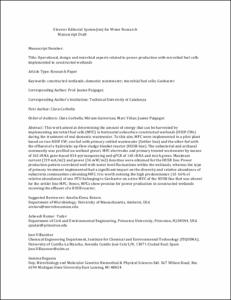Mostra el registre d'ítem simple
Operational, design and microbial aspects related to power production with microbial fuel cells implemented in constructed wetlands
| dc.contributor.author | Corbella Vidal, Clara |
| dc.contributor.author | Guivernau Ribalta, Miriam |
| dc.contributor.author | Viñas Canals, Marc |
| dc.contributor.author | Puigagut Juárez, Jaume |
| dc.contributor.other | Universitat Politècnica de Catalunya. Departament d'Enginyeria Civil i Ambiental |
| dc.date.accessioned | 2016-03-30T14:15:11Z |
| dc.date.available | 2016-08-15T00:30:50Z |
| dc.date.issued | 2015-11-01 |
| dc.identifier.citation | Corbella, C., Guivernau, M., Viñas , M., Puigagut, J. Operational, design and microbial aspects related to power production with microbial fuel cells implemented in constructed wetlands. "Water research (Oxford)", 01 Novembre 2015, vol. 84, p. 232-242. |
| dc.identifier.issn | 0043-1354 |
| dc.identifier.uri | http://hdl.handle.net/2117/84893 |
| dc.description.abstract | This work aimed at determining the amount of energy that can be harvested by implementing microbial fuel cells (MFC) in horizontal subsurface constructed wetlands (HSSF CWs) during the treatment of real domestic wastewater. To this aim, MFC were implemented in a pilot plant based on two HSSF CW, one fed with primary settled wastewater (Settler line) and the other fed with the effluent of a hydrolytic upflow sludge blanket reactor (HUSB line). The eubacterial and archaeal community was profiled on wetland gravel, MFC electrodes and primary treated wastewater by means of 16S rRNA gene-based 454-pyrosequencing and qPCR of 16S rRNA and mcrA genes. Maximum current (219 mA/m(2)) and power (36 mW/m(2)) densities were obtained for the HUSB line. Power production pattern correlated well with water level fluctuations within the wetlands, whereas the type of primary treatment implemented had a significant impact on the diversity and relative abundance of eubacteria communities colonizing MFC. It is worth noticing the high predominance (13-16% of relative abundance) of one OM belonging to Geobacter on active MFC of the HUSB line that was absent for the settler line MFC. Hence, MFC show promise for power production in constructed wetlands receiving the effluent of a HUSB reactor. (C) 2015 Elsevier Ltd. All rights reserved. |
| dc.format.extent | 11 p. |
| dc.language.iso | eng |
| dc.rights.uri | http://creativecommons.org/licenses/by-nc-nd/3.0/es/ |
| dc.subject | Àrees temàtiques de la UPC::Energies::Energia de la biomassa |
| dc.subject.lcsh | Biomass energy |
| dc.subject.lcsh | Constructed wetlands |
| dc.subject.other | Constructed wetlands |
| dc.subject.other | Domestic wastewater |
| dc.subject.other | Microbial fuel cells |
| dc.subject.other | Geobacter |
| dc.subject.other | WASTE-WATER TREATMENT |
| dc.subject.other | INTERSPECIES ELECTRON-TRANSFER |
| dc.subject.other | ELECTRICITY-GENERATION |
| dc.subject.other | GEOBACTER-SULFURREDUCENS |
| dc.subject.other | BIOFUEL CELLS |
| dc.subject.other | FLOW |
| dc.subject.other | REMOVAL |
| dc.subject.other | PLANTS |
| dc.subject.other | COMMUNITIES |
| dc.subject.other | PERFORMANCE |
| dc.title | Operational, design and microbial aspects related to power production with microbial fuel cells implemented in constructed wetlands |
| dc.type | Article |
| dc.subject.lemac | Energia de la biomassa |
| dc.subject.lemac | Zones humides artificials |
| dc.contributor.group | Universitat Politècnica de Catalunya. GEMMA - Grup d'Enginyeria i Microbiologia del Medi Ambient |
| dc.identifier.doi | 10.1016/j.watres.2015.06.005 |
| dc.rights.access | Open Access |
| local.identifier.drac | 17072519 |
| dc.description.version | Postprint (published version) |
| local.citation.author | Corbella, C.; Guivernau, M.; Viñas, M.; Puigagut, J. |
| local.citation.publicationName | Water research (Oxford) |
| local.citation.volume | 84 |
| local.citation.startingPage | 232 |
| local.citation.endingPage | 242 |
Fitxers d'aquest items
Aquest ítem apareix a les col·leccions següents
-
Articles de revista [3.006]
-
Articles de revista [202]


